Zebra Finch
Taeniopygia guttata
The male zebra finch creates a unique song by drawing inspiration from its parent or tutor
Advertisement
Zebra Finch Scientific Classification
- Kingdom
- Animalia
- Phylum
- Chordata
- Class
- Aves
- Order
- Passeriformes
- Family
- Estrildidae
- Genus
- Taeniopygia
- Scientific Name
- Taeniopygia guttata
Read our Complete Guide to Classification of Animals.
Zebra Finch Conservation Status
Zebra Finch Facts
- Prey
- Seeds, fruits, vegetables, and insects
- Fun Fact
- The male zebra finch creates a unique song by drawing inspiration from its parent or tutor
- Estimated Population Size
- Unknown
- Biggest Threat
- Predators
- Most Distinctive Feature
- The speckled or striped plumage along the sides and tail
- Wingspan
- 8-9 inches
- Incubation Period
- 2 weeks
- Habitat
- Savannas and grasslands
- Predators
- Marsupials, snakes, mice, and birds of prey
- Diet
- Omnivore
- Type
- Bird
- Common Name
- Zebra Finch
- Number Of Species
- 1
- Location
- Australia and Timor
- Nesting Location
- Trees, bushes, or burrows
- Age of Molting
- 3 weeks
View all of the Zebra Finch images!
The zebra finch is a small songbird (and a formal member of the estrildid finches) whose origin is the southern Pacific region.
Perched atop a branch or log, the male emits a unique composition of his own making to woo a prospective mate. Common in the wild, they are also fairly popular in the exotic pet trade for their gregarious behavior and upbeat, almost conversational voices.
See all of our expert product reviews.
5 Amazing Zebra Finch Facts
- Zebra finches are considered to be a model organism. Scientists study them to learn about the mating behavior, social interactions, and sounds of similar birds (like the closely related estrildid finches).
- The male zebra finch is capable of composing unique songs. This behavior is so interesting that scientists have studied the finch’s genome for its implications in the evolution of human speech. It’s known that mutations in important genes will produce changes and even impairments in the bird’s sounds.
- The zebra finch was first described by the French ornithologist Louis Jean Pierre Vieillot in 1817.
- The zebra finch was one of the first birds to have its genome sequenced.
- The zebra finch exhibits some surprisingly human-like aspects in its mating behavior. For instance, there’s a clear tension between complete faithfulness and infidelity with its mate. It’s also been observed that chicks are more likely to survive childhood when the parents can freely choose their mates (as opposed to forced bonding), which may suggest an element of attraction is at play in their relationships. “Happy” pairs make for better parents. This is only a hypothetical suggestion, however, and merits further study.
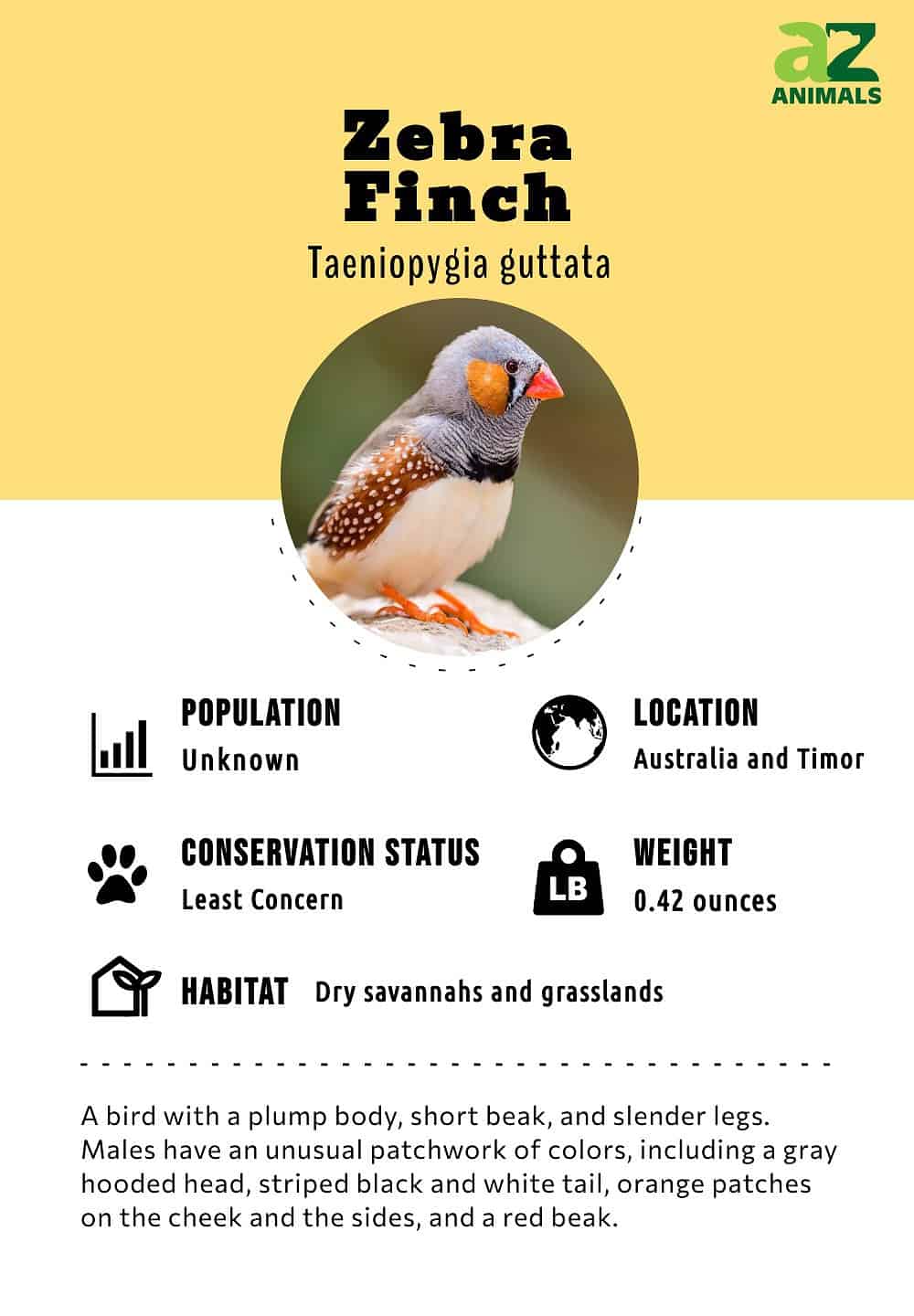
Habitat
The zebra finch’s original habitat is the dry savannahs and grasslands of Australia and Timor (a Pacific island divided between the nations of Indonesia and East Timor). From these small origins, it has spread around the entire world as a domestic pet.
Zebra Finch Nests
The zebra finch can construct a nest almost anywhere, including trees, bushes, or burrows, out of grasses, feathers, or wool.
Scientific Name
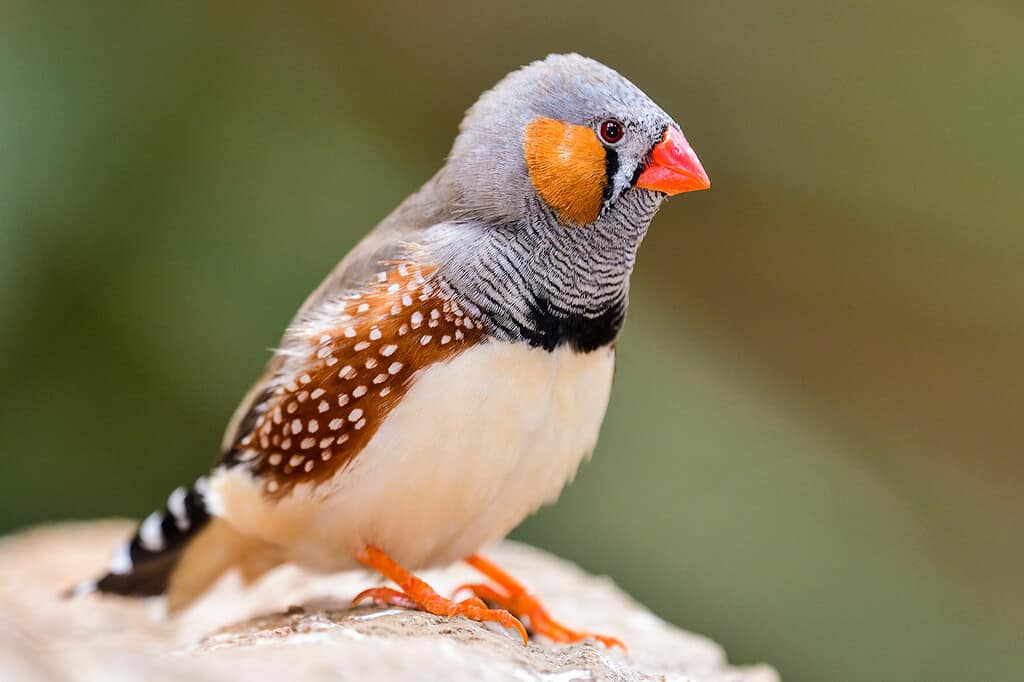
The Zebra Finch belongs to its own genus,
Taeniopygia
.
©iStock.com/Tom Meaker
Health and Entertainment for your Zebra Finch
See all of our expert product reviews.
The scientific name of the zebra finch is Taeniopygia guttata. Guttata is derived from a Latin term that means spotted or speckled. The zebra finch belongs to the family of tropical Australian/Asian finches called estrildids. The genus to which it belongs is far less certain, however. Some experts have classified the zebra finch (and the closely related double-barred finch) in the genus Poephila, while others insist on a separate genus of Taeniopygi. Most analyses support the latter notion that both the zebra and double-barred finch are members of their own separate genus. There are also two subspecies of zebra finch, one from the island of Timor and the other from Australia.
Evolution And Origin
The zebra finch is endemic to Australasia and shares a common ancestor with estrildid finches, which includes the black-throated and the masked finch. The zebra began to diverge into its own separate species around 2.9 million years ago and even though it has been put in the same species as the double-barred finch, these two bird lines have been their own species since about 3.5 million years ago. The two species of zebra finch, while probably getting their start in what is now Australia, were most likely separated due to a glacial event that occurred over 2 million years ago, during the Pleistocene era.
Types Of
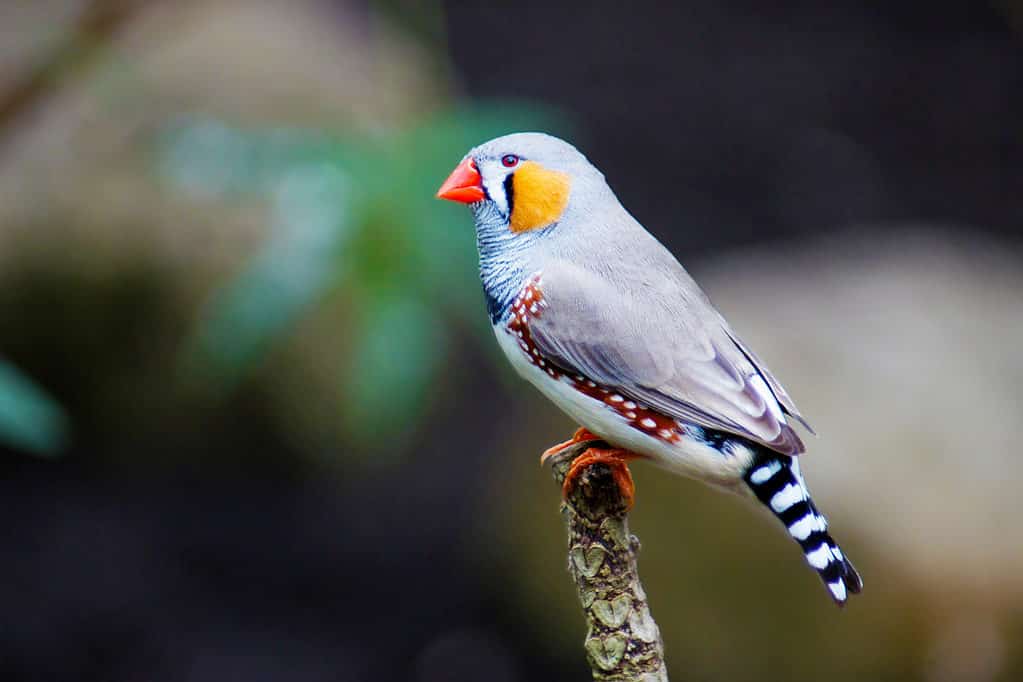
Zebra finches include two species in the genus
Taeniopygia.
©Natalia van D/Shutterstock.com
There are 234 recognized species of finches, but the zebra finch includes two species that are in its genus Taeniopygia. Those are the Australian zebra finch (Taeniopygia castanotis), found in Australia. and the Sunda zebra finch (Taeniopygia guttata), found in Indonesia, more specifically Timor. These species had been previously classified as one species but were split into two separate species in 2016 by the Internation Union for Conservation of Nature (IUCN).
Size, Appearance, And Behavior
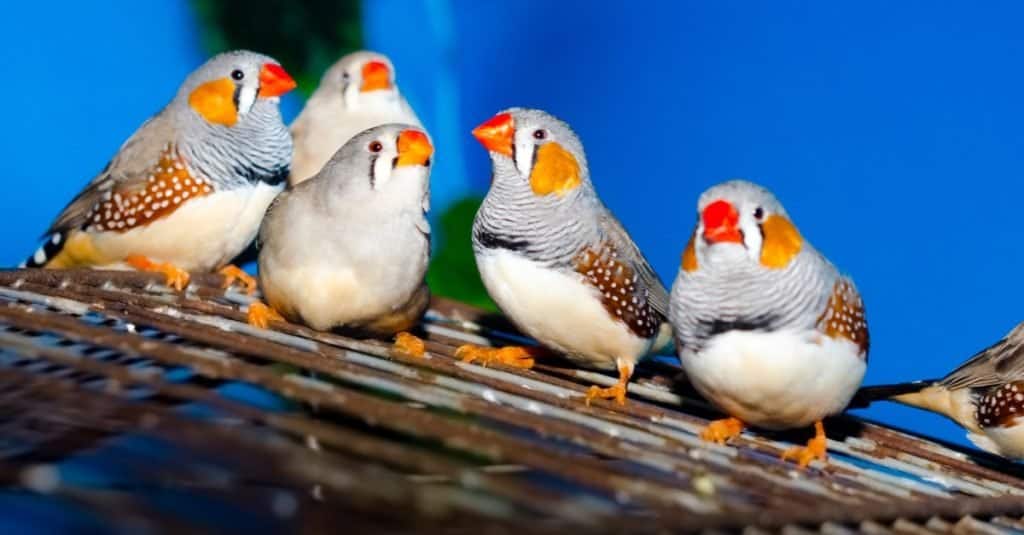
The z
ebra finch sitting on the metal bars of the cage.©ChocoPie/Shutterstock.com
This finch is a small bird, measuring no more than 4 inches in length, with a plump body, short beak, and slender legs. There is a strong element of sexual variation in the plumage. Males exhibit an unusual patchwork of colors, including a gray hooded head, a striped black and white tail that gives it the name, orange patches on the cheek and the sides, and a red beak. Females, however, have simpler gray-colored bodies with orange beaks.
Occasionally, a novel mutation will arise and give birth to new color morphs. While these color morphs are quite rare in nature (they almost never become “fixed” in a population), they can be selected and then amplified by people through successive breeding of that rare mutation. These can produce unusual color combinations like orange breasts, yellow beaks, black cheeks, or all-white plumage.
The social life of the zebra finch revolves around large flocks of about 100 individuals (or only about 50 as the breeding time approaches). These birds do most of their hunting, roosting, and preening in close proximity to other members of the flocks. While they do sometimes travel together a few miles in search of food, flocks also have a defined home range from which they rarely stray for long. Zebra finches are quite friendly and gregarious; they have the ability to recognize and distinguish other individuals, but they will also sometimes chase away outsiders from their home range.
One of the most interesting aspects of zebra finch behavior is the male’s ability to create beautiful songs to attract a mate. They learn to sing from a father or male tutor and then gradually begin to practice the song over the first few weeks of their lives. One study suggests they even lip sync in their sleep, perhaps as a way to package and store long-term information about the song in the brain. The tutor’s song functions as a template, but the chick will add its own variations over time. In this way, no two songs are exactly the same. While bird song is a male-only behavior, both sexes are able to make several complex sounds to communicate with each other.
Diet
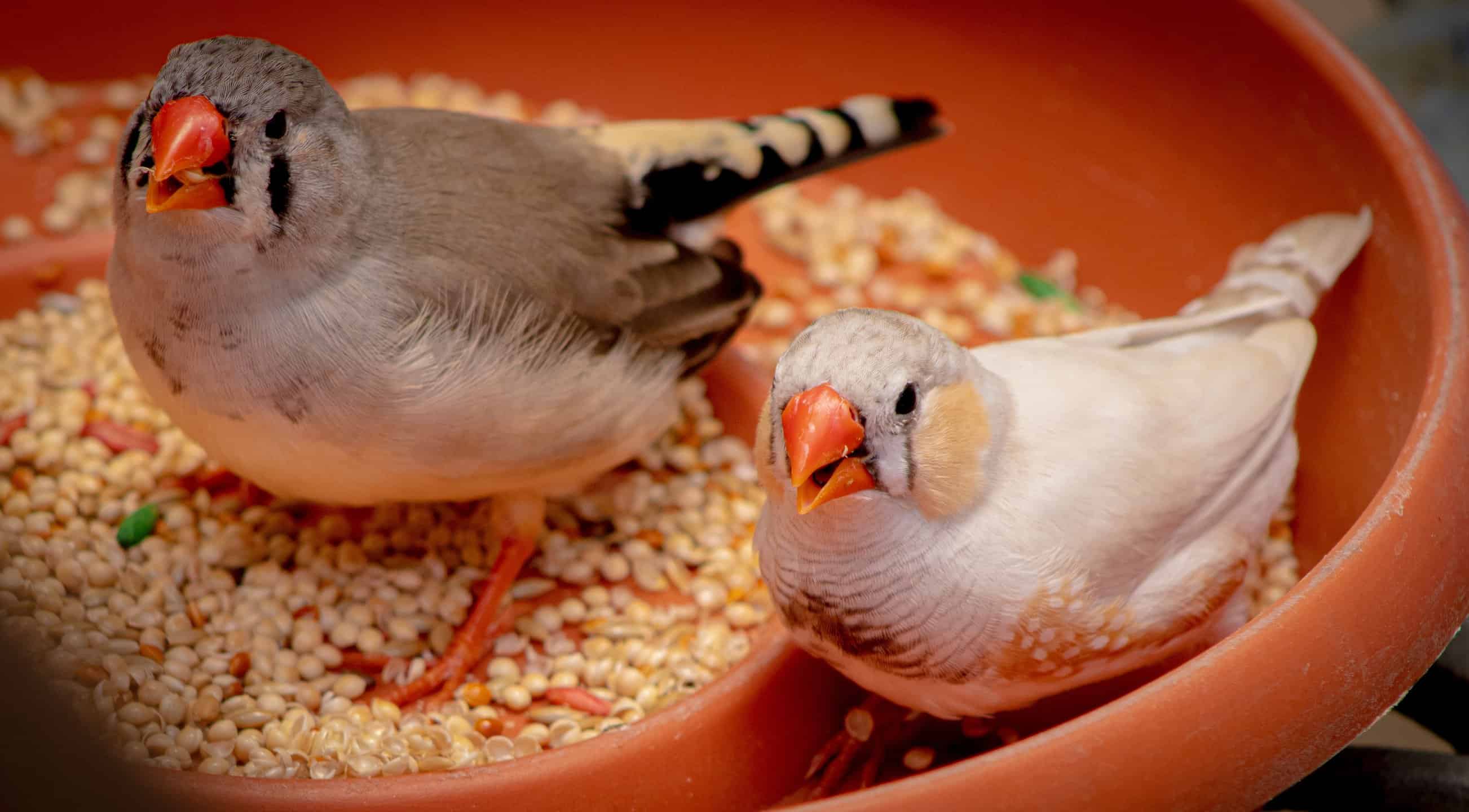
The bulk of the zebra finch’s diet is made up of plant matter.
©Wirestock Creators/Shutterstock.com
This finch is an omnivorous bird, although the bulk of its diet consists of plant matter.
What Does The Zebra Finch Eat?
The zebra finch consumes various types of seeds, fruits, vegetables, and insects. Their stout beaks are well-adapted for dehusking seeds.
Predators, Threats, And Conservation Status
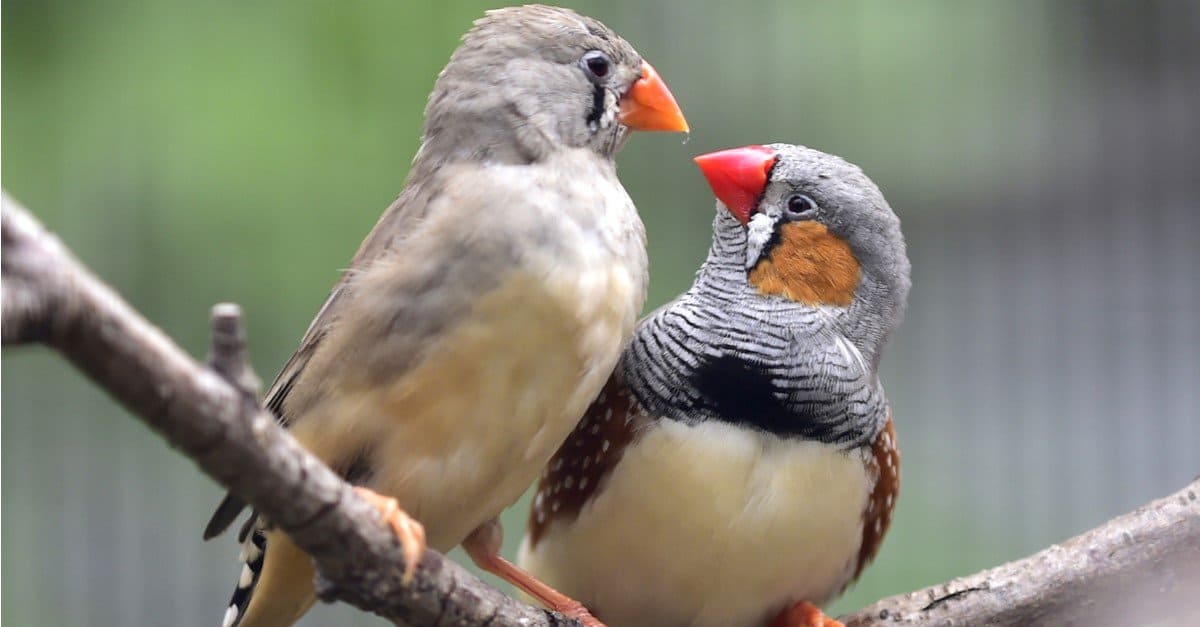
Zebra finches are currently not threatened by human activity.
©Wang LiQiang/Shutterstock.com
These finches are currently classified as a species of least concern by the IUCN Red List. Besides natural predators and diseases, this species is not currently threatened by human activity.
What Eats The Zebra Finch?
The zebra finch is preyed upon by marsupials, snakes, and birds of prey. The eggs are also consumed by mice.
Reproduction, Young, And Molting
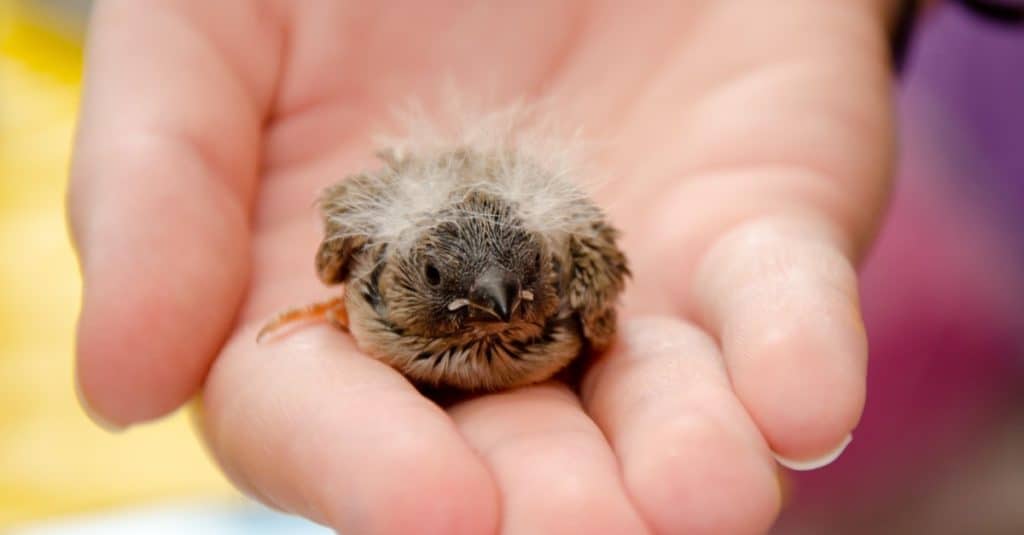
Baby Zebra Finches have gray plumage like their mothers.
©Olena Kurashova/Shutterstock.com
These finches have a highly flexible and opportunistic breeding strategy. Instead of a defined mating season, this bird will wait until there is a substantial amount of rainfall to begin the mating process. The male will then engage in a complicated courtship dance and a unique song they’ve cobbled together. The finch forms lifelong monogamous pair bonds, but based on DNA analysis, it’s also known that they engage in infidelity as well.
After mating, the finch will begin to construct a nest so it can lay a clutch of four to six eggs over a span of a few days. The male is responsible for guarding the nest, while the female incubates the eggs. After the eggs hatch two weeks later, the chicks sport a simple gray plumage like the mother. Both parents will take turns sitting on the nest and feeding the young. The chicks will begin to fly for the first time after three weeks, but it will be another two weeks before they are fully independent of their parents. When all the chicks have departed the nest, the parents may lay another clutch of eggs.
These finches have a relatively short lifespan of about two to three years on average. Because of predation, disease, or accidents, many of them die within the first year of their lives. When they’re in human care, however, the average lifespan is five to seven years.
Population
While it’s not known how many of these finches remain in their wild habitat, population numbers appear to be fairly stable.
View all 14 animals that start with ZZebra Finch FAQs (Frequently Asked Questions)
Does the zebra finch migrate?
No, the zebra finch is a sedentary bird.
How many eggs does the zebra finch lay?
The zebra finch lays four to six eggs per clutch, but it can lay multiple clutches per year.
How fast does the zebra finch fly?
The top flight speed is unknown.
What is the zebra finch’s wingspan?
The zebra finch has a wingspan of about 8 to 9 inches.
When do zebra finches leave the nest?
Chicks leave the nest of origin about five weeks after hatching.
Is a zebra finch a good pet?
The zebra finch is often desired as a pet for its small size, docile and friendly temperament, unique plumage, easy care, and beautiful song. But keep in mind, these birds do need large cages at least 30 inches long to fly around in. They also do not generally respond to human commands or form strong bonds with people. Do not force contact on them, but instead let the bird decide when to interact with you.
How many zebra finches should be kept together?
Since housing size is a constraint, two or three zebra finches are usually fine together.
Can a zebra finch live alone?
Since the zebra finch is highly social, it’s ideal to house multiple birds together.
How long do zebra finches live as pets?
In captivity, the zebra finch can live five years or more. The maximum lifespan is around 12 to 15 years.
What do zebra finches eat?
The zebra finch will do best in your care with high-quality seed mix, fruits, vegetables, and other greens.
Thank you for reading! Have some feedback for us? Contact the AZ Animals editorial team.
Sources
- Animal Diversity Web / Accessed June 26, 2021
- Smithsonian Magazine / Accessed June 26, 2021
- Sci-News / Accessed June 26, 2021
- The Spruce Pets / Accessed June 26, 2021


















